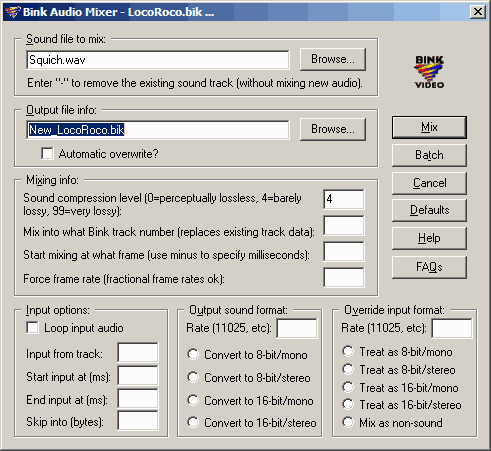
Mixing audio into a Bink file
Mixing audio is the process of interleaving little bits of sound data into each video frame. Normally, you won't have to perform this task, because Bink will compress the audio track of an AVI or QuickTime automatically as it compresses the video frames. You only need to use the mixer when you want to replace or add another audio track to a Bink file, or if you want multi-channel audio output.
Bink supports any number of audio tracks in a Bink video file, and can route each audio track to specific speakers on multichannel audio systems. Bink's support for any number of audio tracks is also handy because you can put multiple languages in one Bink file and select between them at runtime.
To mix audio into a Bink file, just highlight a Bink file and an audio file to mix in (hold down the Control key while clicking your mouse to highlight more than one file at a time). Once the files are selected, click the "Mix in Audio" button to open the mixer window. The mixer window will open with the following options. You can click on the screenshot, or select from the following links to jump right to the help topic you need.
For 5.1 or 7.1 audio, you simply mix multiple stereo or mono input files into different Bink tracks IDs, one at a time. These separate input files are called "stems" in video editing software. Once you have mixed all the input files into Bink audio tracks, just tell your programmers the layout of the Bink tracks (like, track ID 0 is front left-right, etc). The programmer then directs the Bink audio tracks to the proper speaker at runtime.

Sound file to mix:
This option lets you change the sound file that the mixer is going to use for the sound track. This is convenient when you want to compress an audio file in another directory. If you want to remove an audio track, use "-" for the sound file name to mix.
Output file settings:
Enter the filename that you'd like to mix into in this field. You can use the Browse button to choose a directory with your mouse. Use the "automatic overwrite" switch when you don't want Bink to ask you if you want to overwrite the destination filename.
Mixing settings:
Sound compression level: The Sound compression level controls how much audio compression Bink applies. Bink's powerful audio codec is capable of up to 10 to 1 compression in perceptually lossless mode (which basically means you can save a ton of space in your audio tracks without hearing any compression artifacts). Bink compresses 44Khz data the best, and because it compresses the data so well, you should just get used to leaving 11 and 22 Khz behind. Bink still supports 11 and 22 Khz, but the compression ratios are lower (3 to 1 and 5 to 1). Quality level 4 is perceptually lossless on most files, and many files can even use a setting of 5 or 6. Settings of 9 and higher get pretty noisy.
Mix into Bink track ID: This option lets you choose a specific track ID number to mix the audio into. Track ID numbers are completely under your control - you can use whatever number you like - they don't have to be contiguous, monotonic, or even increasing. If you use a track ID that alreay exists in the file, then that track data is replaced with the new track data.
Start mixing at what frame number: Here is where you choose the frame number that you want the mixing to begin on. Actually, the mixing really always starts from the first frame, and this function pads the input data with enough silence to cause the sound track to begin exactly on your chosen frame number. You can also use a millisecond offset by entering a negative number. For example, 2000 would start the sound 2 seconds into the movie.
Force frame rate: Use this option to force a new frame rate on the output Bink file. You'll need to set this option when you compress still images, because they have a default rate of 10 frames per second.
Audio settings:
Convert Audio: Check this box to convert the audio from the input file. If you are converting just audio, then the output file will be a wave file. If you are converting video and audio, then the output file will be an AVI file.
Input Options:
- Loop input audio: This option tells Bink to loop the audio throughout the entire Bink movie.
- Input from track: This option tells the RAD Converter what track to read the audio from. It supports both Video for Windows and QuickTime formats.
- Start input at (ms): This switch, in combination with the following "End input" are the tools you need for mixing a specific sub-section of audio data out of a larger sound file. This is the start point of your range -- it is specified in milliseconds.
- End input at (ms): This switch defines the end point of a specific sub-section of audio data out of a larger sound file. This value is specified in milliseconds.
- Skip into (bytes): This field tells the RAD Converter to skip into the specified sound file before beginning the mixing process. It is usually used with the "Override input format" fields to skip over an unsupported sound format header.
Convert output format: These fields allow you to convert to another sound format during compression. They are there for your convenience, but for maximum quality, you should always start with original high-quality recordings. The RAD Converter can convert a 22 Khz file up to a 44 Khz file, but it can't make it magically sound any better that the original 22 Khz.
Override input format: These fields force a input new format - they don't convert! This is usually only used with RAW sound files that have no header information to identify their sound format.